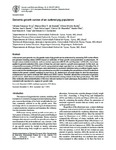Use este identificador para citar ou linkar para este item:
http://www.alice.cnptia.embrapa.br/alice/handle/doc/983083Registro completo de metadados
| Campo DC | Valor | Idioma |
|---|---|---|
| dc.contributor.author | SILVA, F. F. e | pt_BR |
| dc.contributor.author | RESENDE, M. D. V. de | pt_BR |
| dc.contributor.author | ROCHA, G. S. | pt_BR |
| dc.contributor.author | DUARTE, D. A. S. | pt_BR |
| dc.contributor.author | LOPES, P. S. | pt_BR |
| dc.contributor.author | BRUSTOLIN, O. J. B. | pt_BR |
| dc.contributor.author | THUS, S. | pt_BR |
| dc.contributor.author | VIANA, J. M. S. | pt_BR |
| dc.contributor.author | GUIMARÃES, S. E. F. | pt_BR |
| dc.date.accessioned | 2014-03-21T11:11:11Z | pt_BR |
| dc.date.available | 2014-03-21T11:11:11Z | pt_BR |
| dc.date.created | 2014-03-21 | pt_BR |
| dc.date.issued | 2013 | pt_BR |
| dc.identifier.citation | Genetics and Molecular Biology, v. 36, n. 4, p. 520-527, 2013. | pt_BR |
| dc.identifier.uri | http://www.alice.cnptia.embrapa.br/alice/handle/doc/983083 | pt_BR |
| dc.description | In the current post-genomic era, the genetic basis of pig growth can be understood by assessing SNP marker effects and genomic breeding values (GEBV) based on estimates of these growth curve parameters as phenotypes. Although various statistical methods, such as random regression (RR-BLUP) and Bayesian LASSO (BL), have been applied to genomic selection (GS), none of these has yet been used in a growth curve approach. In this work, we compared the accuracies of RR-BLUP and BL using empirical weight-age data from an outbred F2 (Brazilian Piau X commercial) population. The phenotypes were determined by parameter estimates using a nonlinear logistic regression model and the halothane gene was considered as a marker for evaluating the assumptions of the GS methods in relation to the genetic variation explained by each locus. BL yielded more accurate values for all of the phenotypes evaluated and was used to estimate SNP effects and GEBV vectors. The latter allowed the construction of genomic growth curves, which showed substantial genetic discrimination among animals in the final growth phase. The SNP effect estimates allowed identification of the most relevant markers for each phenotype, the positions of which were coincident with reported QTL regions for growth traits. | pt_BR |
| dc.language.iso | eng | eng |
| dc.rights | openAccess | eng |
| dc.subject | Melhoramento genético | pt_BR |
| dc.title | Genomic growth curves of an outbred pig population. | pt_BR |
| dc.type | Artigo de periódico | pt_BR |
| dc.date.updated | 2015-02-18T11:11:11Z | pt_BR |
| dc.subject.thesagro | Curva de Crescimento | pt_BR |
| dc.subject.thesagro | Porco | pt_BR |
| riaa.ainfo.id | 983083 | pt_BR |
| riaa.ainfo.lastupdate | 2015-02-18 | pt_BR |
| dc.contributor.institution | FABIANO FONSECA E SILVA, UFV; MARCOS DEON VILELA DE RESENDE, CNPF; GILSON SILVÉRIO ROCHA, UVF; DARLENE ANA S. DUARTE, UFV; PAULO SÁVIO LOPES, UFV; OTÁVIO J. B. BRUSTOLIN, UFV; SANDER THUS, WAGENINGEN UNIVERSITY; JOSÉ MARCELO S. VIANA, UFV; SIMONE E. F. GUIMARÃES, UFV. | pt_BR |
| Aparece nas coleções: | Artigo em periódico indexado (CNPF)  | |
Arquivos associados a este item:
| Arquivo | Descrição | Tamanho | Formato | |
|---|---|---|---|---|
| 2013APIGenomicGrowth.pdf | 650.8 kB | Adobe PDF |  Visualizar/Abrir |









